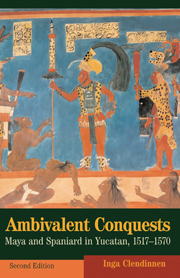Book contents
- Frontmatter
- Contents
- List of illustrations
- Preface to the second edition
- Preface to the first edition
- Acknowledgments
- Map I Yucatan in the conquest period
- Part I Spaniards
- Part II Indians
- 9 Finding out
- 10 Connections
- 11 Continuities
- 12 Assent
- Epilogue: Confusion of tongues
- Appendix: A sampler of documents
- Glossary of Spanish and Maya terms
- Notes
- Select bibliography
- Index
9 - Finding out
Published online by Cambridge University Press: 05 October 2013
- Frontmatter
- Contents
- List of illustrations
- Preface to the second edition
- Preface to the first edition
- Acknowledgments
- Map I Yucatan in the conquest period
- Part I Spaniards
- Part II Indians
- 9 Finding out
- 10 Connections
- 11 Continuities
- 12 Assent
- Epilogue: Confusion of tongues
- Appendix: A sampler of documents
- Glossary of Spanish and Maya terms
- Notes
- Select bibliography
- Index
Summary
This is a record of the things they did. After it had all passed, they told of it in their own words, but its meaning is not plain. Still the course of events was as it is written … Still he who comes of our lineage will know it, one of us who are Maya men …
The Book of Chilam Balam of ChumayelIs it possible to discover anything of the views and experience of a people whose voices were hushed to a murmur more than 400 years ago? In the preface of his The Making of the English Working Class, E. P. Thompson declared in a splendid phrase his determination to rescue ordinary English working men and women from ‘the enormous condescension of posterity,’ and proceeded to do so. Rescuing the native peoples so casually appropriated to European uses (symbolic and material) over these last centuries presents essentially the same problems – the necessary dependence on outsider reports, for example – at an even more daunting level of intensity. Alien soldiers rarely make sensitive ethnographers. The Spaniards who conquered the peninsula, from Córdoba's ragged hopefuls to the hard men who fought the last campaigns, were concerned with survival and victory. What they saw they saw well: the shape and size of settlements; the swift obedience of commoners to their chiefs; goods produced and exchanged; how work was distributed. But it was a narrowly instrumental perspective, and one inevitably entailing distortion, as the unfamiliar was wrenched into familiar, and so potentially manipulable, forms.
- Type
- Chapter
- Information
- Ambivalent ConquestsMaya and Spaniard in Yucatan, 1517–1570, pp. 131 - 138Publisher: Cambridge University PressPrint publication year: 2003

